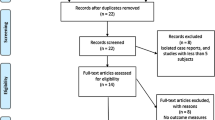Abstract
Purpose
The aim of this study was to determine a plain radiographic criterion for determining the feasibility of using the standard anterior Smith-Robinson supramanubrial approach for anterior surgery down to T2 or T3.
Methods
The surgical database (2002–2014) was searched to identify patients with anterior cervical surgery to T2 or T3. A method to determine whether a standard anterior Smith-Robinson approach can be used to operate on the upper thoracic levels was evaluated. The surgeon chose the surgical approach preoperatively using a lateral radiograph by determining if a line from the intended skin incision to the lower instrumented level (LIV) passed above the top of the manubrium. If so, a standard Smith-Robinson approach was selected. Another spine surgeon then analyzed all patients who had anterior thoracic fusion to T2 or below. The lateral radiographs were retrospectively reviewed.
Results
A total of 44 patients who underwent anterior surgery down to T2 or T3 vertebrae were identified. T2 was the LIV in 39 patients. T3 was the LIV in five patients. No surgery was abandoned or converted to a difference approach after making the standard Smith-Robinson approach. To increase visualization, T1 corpectomy was necessary in 4 of 39 patients when T2 was the LIV. T2 corpectomy was necessary in 2 of 5 patients when T3 was the LIV.
Conclusion
If a line from the intended skin incision to the LIV passes over the top of the manubrium, a standard Smith-Robinson approach without sternotomy can be successfully used.


Similar content being viewed by others
References
An HS, Vaccaro A, Cotler JM, Lin S (1994) Spinal disorders at the cervicothoracic junction. Spine (Phila Pa 1976) 19:2557–2564
Cauchoix J, Binet JP (1957) Anterior surgical approaches to the spine. Ann R Coll Surg Engl 21:234–243
Sar C, Hamzaoglu A, Talu U, Domanic U (1999) An anterior approach to the cervicothoracic junction of the spine (modified osteotomy of manubrium sterni and clavicle). J Spinal Disord 12:102–106
Sundaresan N, Shah J, Feghali JG (1984) A transsternal approach to the upper thoracic vertebrae. Am J Surg 148:473–477
Harrop JS, Silva MT, Sharan AD, Dante SJ, Simeone FA (2003) Cervicothoracic radiculopathy treated using posterior cervical foraminotomy/discectomy. J Neurosurg 98:131–136
Rao S, Badani KM, Jamieson K, Schildhauer T (1996) Pitfalls in the surgical management of cervical spine injuries. Eur Spine J 5:153–160
Zacharias A, Habib RH (1996) Factors predisposing to median sternotomy complications. Deep vs superficial infection. Chest 110:1173–1178
Kaya RA, Turkmenoglu ON, Koc ON, Genc HA, Cavusoglu H, Ziyal IM, Aydin Y (2006) A perspective for the selection of surgical approaches in patients with upper thoracic and cervicothoracic junction instabilities. Surg Neurol 65:454–463. doi:10.1016/j.surneu.2005.08.017 (discussion 463)
Pointillart V, Aurouer N, Gangnet N, Vital JM (2007) Anterior approach to the cervicothoracic junction without sternotomy: a report of 37 cases. Spine (Phila Pa 1976) 32:2875–2879. doi:10.1097/BRS.0b013e31815b7632
Cho W, Buchowski JM, Park Y, Maeda T, Nabb CE, Riew KD (2012) Surgical approach to the cervicothoracic junction: can a standard Smith-Robinson approach be utilized? J Spinal Disord Tech 25:264–267. doi:10.1097/BSD.0b013e31821c2d60
Falavigna A, Righesso O, Teles AR (2011) Anterior approach to the cervicothoracic junction: proposed indication for manubriotomy based on preoperative computed tomography findings. J Neurosurg Spine 15:38–47. doi:10.3171/2011.3.SPINE10342
Falavigna A, Righesso O, Betemps A, Vela de los Rios PF, Guimaraes R, Ziegler M, de Souza OE, da Silva PG, Riew DK (2014) Surgical planning and neurological outcome after anterior approach to remove a disc herniation at the C7–T1 level in 19 patients. Spine (Phila Pa 1976) 39:E219–E225. doi:10.1097/BRS.0000000000000109
Fraser JF, Diwan AD, Peterson M, O’Brien MF, Mintz DN, Khan SN, Sandhu HS (2002) Preoperative magnetic resonance imaging screening for a surgical decision regarding the approach for anterior spine fusion at the cervicothoracic junction. Spine (Phila Pa 1976) 27:675–681
Compston A (2010) Aids to the investigation of peripheral nerve injuries. Medical Research Council: Nerve Injuries Research Committee. His Majesty’s Stationery Office: 1942; pp. 48 (iii) and 74 figures and 7 diagrams; with aids to the examination of the peripheral nervous system. By Michael O’Brien for the Guarantors of Brain. Saunders Elsevier: 2010; pp. [8] 64 and 94 figures. Brain 133:2838–2844
Hodgson AR, Stock FE, Fang HS, Ong GB (1960) Anterior spinal fusion. The operative approach and pathological findings in 412 patients with Pott’s disease of the spine. Brit J Surg 48:172–178
Karikari IO, Powers CJ, Isaacs RE (2009) Simple method for determining the need for sternotomy/manubriotomy with the anterior approach to the cervicothoracic junction. Neurosurgery 65:E165–E166. doi:10.1227/01.NEU.0000347472.07670.EB (discussion E166)
Author information
Authors and Affiliations
Corresponding author
Ethics declarations
The manuscript submitted does not contain information about medical device(s)/drug(s).
No funds were received in support of this work.
No relevant financial activities outside the submitted work.
Conflict of interest
None.
Additional information
IRB ID #: 201411078.
From: The Washington University in St. Louis Institutional Review Board.
Rights and permissions
About this article
Cite this article
Singhatanadgige, W., Zebala, L.P., Luksanapruksa, P. et al. Can standard anterior Smith-Robinson supramanubrial approach be utilized for approach down to T2 or T3?. Eur Spine J 26, 2357–2362 (2017). https://doi.org/10.1007/s00586-016-4631-0
Received:
Revised:
Accepted:
Published:
Issue Date:
DOI: https://doi.org/10.1007/s00586-016-4631-0




